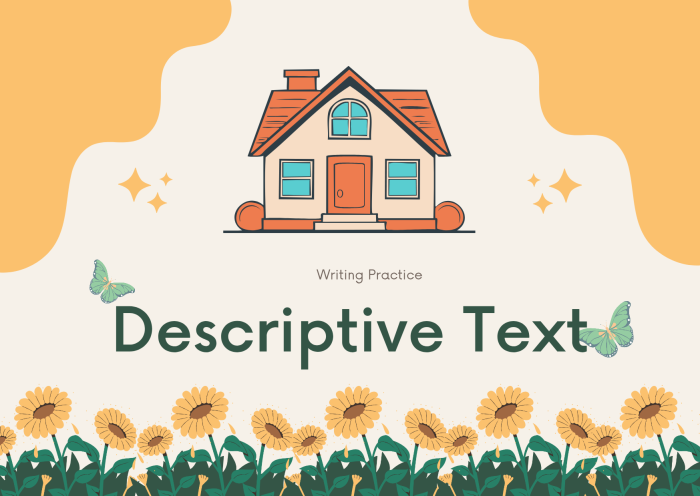Descriptive Text
A descriptive paragraph is a type of writing where you describe a person, place, object, or moment in full detail. The goal is to help the reader imagine exactly what you’re talking about – like it’s happening right in front of them.
It’s not about telling a story. It’s more about showing what something looks like, feels like, or sounds like, using clear and specific words. That’s what makes descriptive paragraph writing feel real and easy to picture.
3 Part of Descriptive Text
- Identification: Writing a descriptive essay allows you to transport readers to a specific place through vivid descriptions. To begin, follow these steps to engage your readers from the very first sentence. Let’s explore how to start a descriptive essay using an example of capturing the essence of a place.
- Description: Whether it’s your school, a park, your hometown, or a busy street – this paragraph should give a full picture of that place. Talk about what you see, hear, or even feel there. A good descriptive paragraph should make the place feel real to the reader, like they’re standing in it. keep detail to describe in five senses description
- Conclusion: A solid closing means a solid essay. Some students think that because it is a closing paragraph, it requires less focus and is less important. But it is not the case. A clumsy conclusion will leave a bad impression, and all your hard work may go to waste. But a conclusion is also not a place for new ideas. Stay brief and to the point.
Writing outline descriptive text of place: https://drive.google.com/file/d/16lBQcfZfsk4NcwYGVKLGJAnhDVUfukuc/view?usp=drive_link , https://drive.google.com/file/d/1cRpE4iNxg7BprwS61aielk0LfEqBVvxy/view?usp=drive_link
Descriptive Paragraph Format – The Secret Recipe You Need
You’re not writing an essay, just one strong paragraph. But it still needs structure. Here’s the format that works every time:
Start with a Clear Introduction
Open with one sentence that tells the reader what you’re about to describe.
Example: “My grandfather is the most inspiring person I know.”
It sets the topic without going into details just yet.
Add Specific Details
Now comes the heart of the paragraph. Use strong adjectives, comparisons, and sensory words to describe what it looks like, sounds like, feels like, etc.
If you’re writing about a person, include habits or expressions. For a place or object, add what stands out about it visually.
Show Some Feeling
Make it personal. Add one line that shows what this thing or person means to you. This makes your writing feel real – not robotic.
Example: “His warm smile always makes me feel safe, even on the worst days.”
Wrap It Up Smoothly
End with a final thought or sentence that wraps your paragraph. Don’t just stop – leave a small conclusion.
Example: “To me, he’s not just my grandfather – he’s my biggest role model.”
Point of five senses in descriptive text: https://drive.google.com/file/d/1K4K-4DEM5q8ab8dd3U2Q2Riod5GWtmNZ/view?usp=drive_link\ , https://drive.google.com/file/d/1Hj8DlvcYYOFfbihcccXglWDB7kHcsCG-/view?usp=drive_link
How to Nail It in 5 Easy Steps
Step 1: Choose a topic you can see
Don’t pick something just because it “sounds cool.” Choose a person, place, or thing you actually remember. Something you’ve seen, felt, or experienced – it makes writing 10x easier.
Example: If you’ve played every evening on your school ground, that’s a perfect topic. You already know how it looks when the sun sets or when the bell rings.
Step 2: Imagine it using your 5 senses
Before you write, close your eyes and think: What do you see, hear, smell, or touch? This is the secret behind a great descriptive paragraph – it brings the scene alive in the reader’s head.
Tip: Don’t describe everything. Pick 2–3 strong details that actually stand out – like the smell of wet soil after rain or the warm noise of a crowded fair.
Step 3: Use real, clear words — not over-smart ones
Forget fancy dictionary terms. Just write how you would speak, but with more detail. Use adjectives, comparisons (like, as, looks like, feels like), and short, strong lines.
Example: “Her laughter was loud, but it always made the whole room feel lighter.”
→ That hits harder than “Her laughter had a positive impact.
Step 4: Stay focused — don’t jump around
A common mistake in descriptive paragraph for class 9 writing? Mixing topics. If you’re describing your grandma’s garden, don’t go off talking about your Neighbour’s dog. Keep every line linked to one central thing – and let all the details support that.
Step 5: Read it like you’re the teacher
When you’re done, read it out loud. Does it feel smooth? Does it actually describe something clearly? Is there a clean start, a middle with details, and a proper wrap-up? If yes, you’re ready to go.
And now try to write your descriptive text essay, describe your lovely house. Keep trying! Write and evaluate your essay with this evaluation rubric checklist https://drive.google.com/file/d/1wzl-TP2pzsiyamt2mQ3_5m74UNkZ2_4F/view?usp=drive_link











